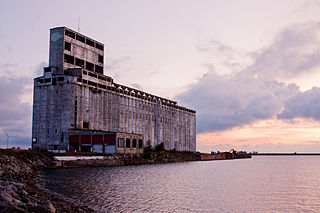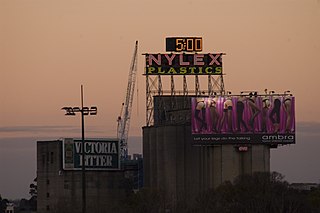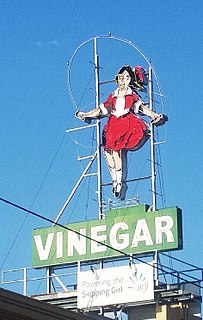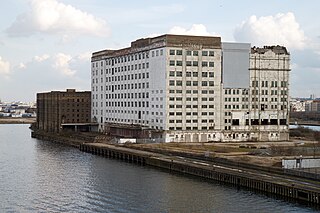
A grain elevator is an agrarian facility complex designed to stockpile or store grain. In the grain trade, the term "grain elevator" also describes a tower containing a bucket elevator or a pneumatic conveyor, which scoops up grain from a lower level and deposits it in a silo or other storage facility.

The Swan Brewery is a brewing company, whose brewery was located in Perth, Western Australia.

The Nylex Clock is heritage listed as an iconic feature of Melbourne and is considered part of the popular culture of the city. It is neon sign sitting atop malting storage silos in the suburb of Cremorne, Victoria, Australia. It is located adjacent to the northern bank of the Yarra River and the Monash Freeway and displays the time and temperature alternately. The text also alternates displaying the words 'Nylex Plastics' that changes to 'Nylex Every Time!'. It is visible from many parts of Melbourne, particularly the Melbourne Cricket Ground. This linkage is referred to in the song "Leaps and Bounds" by musician Paul Kelly and was once climbed by Brisbane-based activists Freshellen Frew, Ag Heard and several other Melbourne-based activists.

108 St Georges Terrace or South32 Tower is a 50-storey office tower in Perth, Western Australia. Completed in 1988, the building measures 214 metres (702 ft) to its roof and 247 metres (810 ft) to the tip of its communications antenna. It was the tallest building in Perth from its completion in 1988 until 1992 when it was overtaken in height by Central Park. As of 2012, it remains the third-tallest building in the city. The concrete tower has a distinctive profile, with a triangular plan.

The Skipping Girl Sign or Skipping Girl Vinegar Sign, colloquially known as Little Audrey is an historic animated neon sign in the inner suburb of Abbotsford, Melbourne, and was possibly the first animated neon sign in Australia when first erected in 1936. It advertised the Skipping Girl Vinegar brand, and was placed on top of the factory at 627 Victoria Street, Abbotsford. Removed in 1968, a reproduction was placed on a nearby factory at 651 Victoria Street in 1970 following a public outcry.

The Pelaco Sign is a heritage-listed neon sign located in the inner Melbourne suburb of Richmond. It was erected in 1939 as an advertisement for local shirt manufacturer Pelaco.

The Old Windmill is a heritage-listed tower mill in Observatory Park adjacent to Wickham Park at 226 Wickham Terrace, Spring Hill, City of Brisbane, Queensland, Australia. It was built in the 1820s by convict labour in the Moreton Bay penal settlement and is the oldest surviving building in Queensland. It is also known as Brisbane Observatory and Windmill Tower. It was added to the Queensland Heritage Register on 21 October 1992. Today it is the centrepiece of Observatory Park.

Borsari's Corner is at the intersection of Lygon Street and Grattan Street, in Carlton, Victoria, Australia. The corner is named after Nino Borsari, a member of the Gold medal winning Italian pursuit cycling team at the 1932 Olympics, who was competing in Australia when World War II broke out. Unable to return home, he established a bicycle repair shop on the corner in 1941. In the late 1940s, a neon sign of Borsari was erected, and is currently of heritage significance. Borsari was active in the local Italian community, organising cultural and welfare activities.

The 1910 Perth Technical School building is located at 137 St Georges Terrace, Perth, Western Australia, adjacent to the Old Perth Boys School building, which had served as part of the school's former temporary premises since opening of classes there on 16 May 1900.

The Albers Brothers Milling Company building is a historic mill and contemporary office building located on the banks of the Willamette River in Portland, Oregon, United States. In the early decades of the 20th century, the German-immigrant Albers brothers built the largest flour and feed milling enterprise on the West Coast, headquartered in Portland and comprising operations in four states. This combined milling, warehousing, shipping, and office facility, built in 1909–1911, is the oldest remaining flour or feed mill in the city. The silos built into the south elevation of the building are painted with representations some of the mill's products as advertisements.

The Millennium Mills is a derelict turn of the 20th century flour mill in West Silvertown on the south side of the Royal Victoria Dock, between the Thames Barrier and the ExCeL London exhibition centre alongside the newly built Britannia village, in Newham, London, England. The Mills are currently undergoing a major renovation as part of a £3.5billion redevelopment of Silvertown.

The Strelitz Buildings, located at 30 Mouat Street, Fremantle, were built in 1897 for Paul and Richard Strelitz. In October 1994, the buildings were permanently listed on the Western Australian State Heritage Register.
Joseph Denis Nunan was an Irish born patriot and builder transported to Fremantle for wounding a policeman. He became an architect and building contractor involved in significant buildings in Perth, Fremantle and York. He never gave up his Fenian beliefs and died before he could return to Ireland.

Defiance Flour Mill is a heritage-listed mill at 269-291 Ruthven Street, Toowoomba, Toowoomba Region, Queensland, Australia. It was designed by Toowoomba architect William Hodgen and built in 1911 by WT Smith. It was added to the Queensland Heritage Register on 26 February 2002.

Wilhemsen House, also known as the Elders Building, Elder Building, Barwil House and the Dalgety & Co. Building, is a heritage building located at 11 Cliff Street on the corner of Phillimore Street in the port city of Fremantle, Western Australia. The building dates from the gold rush boom period in the late nineteenth and early twentieth centuries and is of historic significance.

The Fremantle Synagogue is a heritage listed building located on South Terrace on the corner of Parry Street in Fremantle, Western Australia. It was the first synagogue built in Western Australia and was associated with Jewish community leaders and merchants in Fremantle at the end of the 19th century. The building is also known as Beers building.

The Imperial Chambers building is a heritage building located at 51-57 Market Street on the corner of Leake Street in the Fremantle West End Heritage area. The building dates from the gold rush boom period in the late nineteenth and early twentieth centuries, and is of historic significance.

The Corowa Flour Mill is a heritage-listed former flour mill and now tourist attraction at Steel Street, Corowa, Federation Council, New South Wales, Australia. It is also known as the Corowa Flour Mill and site. It was added to the New South Wales State Heritage Register on 2 April 1999.


















